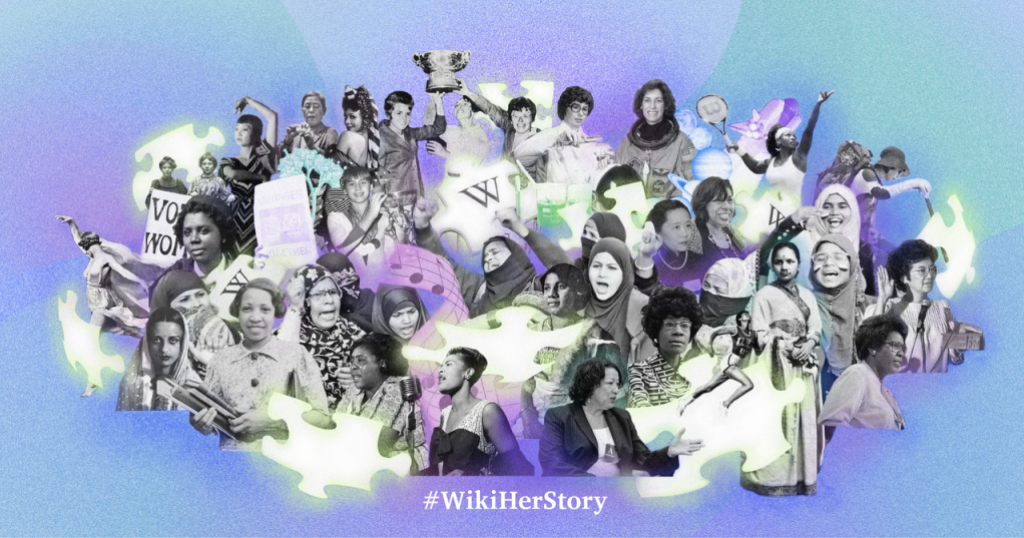
What do a Dutch software developer, a British physicist, and an Indian Wikimedian-in-Residence all have in common? They are just some of the inspiring women featured as part of the Wikimedia Foundation’s #WikiHerStory initiative (Meta page) launched this Women’s History Month (March 2020). Through the initiative, we aimed to build public awareness of community projects that increase gender equity on Wikimedia projects and encourage other people to get involved in these efforts. Read on to learn more about how we got started and some important lessons learned.
Sharing volunteer stories
Through the Wikimedia Foundation blog on Medium and on Instagram, we highlighted stories of women volunteering in the movement around the world to show Wikipedia readers that there are many different ways women participate in the Wikimedia movement. There are experienced and brand new editors; technical contributors; movement organizers; and countless other opportunities to get involved. We wanted to illuminate these different pathways as a way to inspire new folks to get involved in ways that are most meaningful to them. We drafted a list of questions and then conducted interviews with the volunteers over email, which helped make it easier to work across multiple time zones. They sent in photographs, and we developed graphics to accompany the stories.
Updating web materials
We know volunteer communities and affiliates in the Wikimedia movement support a wide variety of projects and initiatives to address the gender gap on Wikimedia projects. For #WikiHerStory, we wanted to draw greater attention to these efforts and provide a central place where anyone could learn more about the gender gap and find ways to get involved in addressing it. To do this, we updated the Foundation’s webpage on Wikipedia’s gender gap to include links to the latest research and data, including new insights from reader research and Community Insights surveys. We also provided a list of ways interested readers could get involved in solving the problem: writing and editing biographies about women; improving content about gender equity, feminism, and the arts; contributing freely-licensed photos of women; joining virtual edit-a-thons during Women’s History Month, and supporting the #WikiHerStory initiative by posting and following on social media. We highlighted numerous affiliates doing important work on gender equity on the projects around the world, such as Art+Feminism and the #WikiGap challenge, and how interested newbies could get involved.
Partnerships with the Smithsonian and UN Human Rights
In the weeks leading up to the #WikiHerStory initiative, we collaborated with The Smithsonian in their announcement to release 2.8 million 2D and 3D images under a Creative Commons license, many of which include collections from and by women. Additionally, the United Nations Human Rights Office included Wikimedia as a partner in their #IStandWithHer campaign which aimed to change the narrative and address bias about women in the world. By collaborating with both The Smithsonian and UN Human Rights, we helped further solidify Wikimedia’s relevance in the space of gender equity, reached new audiences from UN Human Rights and The Smithsonian, and opened the door for future collaborations in this area with institutional partners.
Recommendations
If your community is interested in running a similar initiative, we recommend a few best practices, informed by our own experiences with #WikiHerStory.
- Put people first. Share human stories, like those of affiliate leaders and volunteers. Role models are inspiring to others who are thinking of joining the movement. You could ask a question as simple as “Why do you edit Wikipedia?” and get content for a blog post, tweet, or Instagram caption.
- Develop web materials well in advance of your planned launch date. This could look like a few graphics for Instagram, Twitter, and Facebook to promote an edit-a-thon, for instance, and then setting up a dashboard for participants to join and log their edit-a-thon progress. It could also involve a standalone website or Meta page featuring original content in the form of posts and videos. This made it more effective to ask others to help amplify the initiative and easier for readers to learn how to get involved in Women’s History Month activities.
- Find collaborators who share your values and can help amplify your work. That could include a local influencer, a company or non-profit with a social following willing to help share your event, a government department or educational institution, or anyone else passionate about spreading free knowledge!
- Be adaptable. Not everything will go according to plan, and that’s okay. March was a tumultuous month for global health. As a result of the COVID-19 pandemic, many of the events that we posted about on the gender gap resource page had to be canceled, or the organizers pivoted to hosting virtual events instead. As we learned from this experience, responding with agility and being willing to make adjustments quickly is always valuable — no matter the topic of your campaign. We even used the moment to create a new Medium blog post about women sharing important COVID-19 information on Wikipedia.
Our deep gratitude (and much WikiLove) goes to the partners and volunteers who supported #WikiHerStory and the countless communities who are leading efforts to improve gender equity on the projects. Thank you for working so tirelessly to address this critical issue!

Can you help us translate this article?
In order for this article to reach as many people as possible we would like your help. Can you translate this article to get the message out?
Start translation